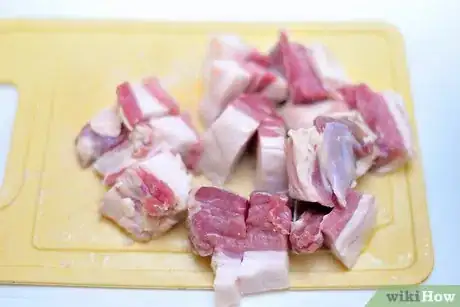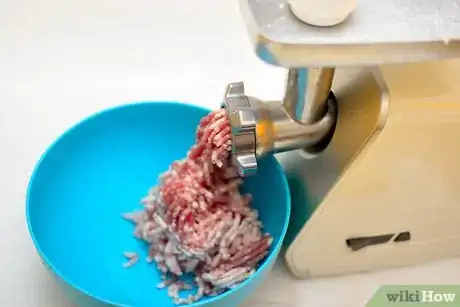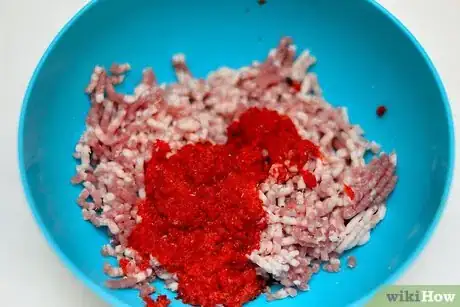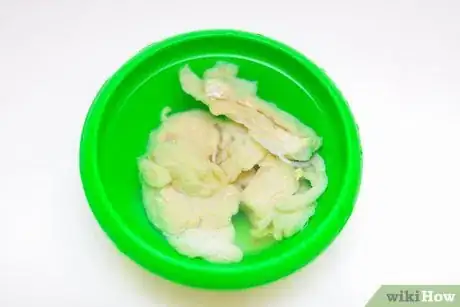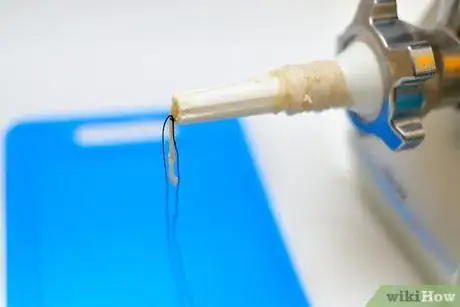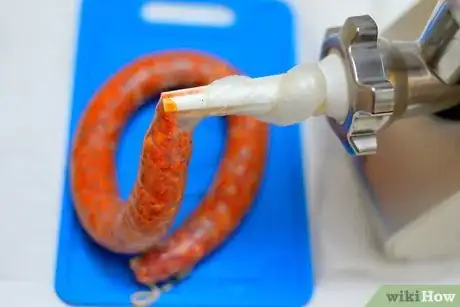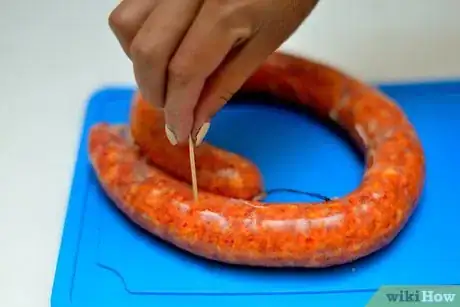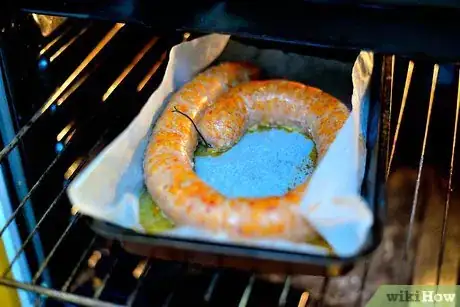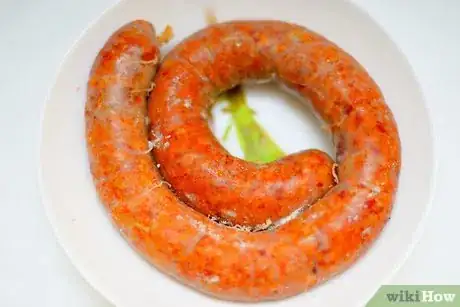This article was co-authored by wikiHow staff writer, Jessica Gibson. Jessica Gibson is a Writer and Editor who's been with wikiHow since 2014. After completing a year of art studies at the Emily Carr University in Vancouver, she graduated from Columbia College with a BA in History. Jessica also completed an MA in History from The University of Oregon in 2013.
This article has been viewed 37,795 times.
Learn more...
Nduja is a traditional Italian sausage from Calabria that's becoming popular. If you'd like to make this rich meat paste at home, buy the highest quality pork meat and fat you can find. Grind it and season with spicy polpa di peperoncino, salt, red wine, and paprika. Then fill your sausage casings and ferment the nduja for a few days before you begin curing it. Cure the nduja for several weeks before you begin enjoying this simple delicacy.
Ingredients
- 2.2 pounds (1.00 kg) pork meat such as pancetta or guanciale
- 2.2 pounds (1.00 kg) pork fat
- 2.2 pounds (1.00 kg) polpa di peperoncino
- 1/3 cup (90 g) salt
- 1 cup (240 ml) red wine
- Sweet and hot paprika to taste
Makes about 7 cups (970 g) of sausage
Steps
Combining the Nduja Mixture
-
1Cut the pork and fat into slices or strips. Place 2.2 pounds (1.00 kg) of pork meat such as pancetta or guanciale and 2.2 pounds (1.00 kg) of pork fat on your work surface. Cut the meat and fat into 2 in (5 cm) wide slices.
- The size of the slices doesn't really matter as long as you can easily fit them into your grinder.
-
2Grind the meat and fat 2 times. Place a few slices of the pork meat into a meat grinder and run it through. Run all of your meat and fat through the grinder and then run the ground meat and fat through the grinder again.[1]
- Use a #10 or #12 plate to grind the pork.
- The mixture should look like a very thick, creamy paste.
Advertisement -
3Combine the pork with popa di peperoncino, salt, wine, and paprika. Transfer the ground pork mixture to a large bowl. Add 2.2 pounds (1.00 kg) polpa di peperoncino, 1/3 cup (90 g) of salt, 1 cup (240 ml) of red wine, and paprika to taste. Use your clean hands or a large wooden spoon to thoroughly mix together the seasonings with the pork.
- You can find polpa di peperoncino at gourmet food stores, Italian meat markets, or online.
- Consider wearing gloves if your skin is sensitive to the peppers.
-
4Rest the mixture for 30 minutes and get out 4 casings. Refrigerate the meat mixture for half an hour while you get ready to fill the sausage casings. You'll need 4 synthetic or natural casings. You should also attach the horn to your grinder so you can begin filling the casings.
- To make the casings slide on easier, wipe the horn with a wet cloth.
Filling the Casings
-
1Soak the casings for 10 minutes to 1 hour depending on the type. If you're using synthetic casings, submerge them in cold water for 10 minutes before you begin filling them. If you're using salted natural casings, rinse and soak them in room temperature water for 15 minutes to 1 hour.
- For natural casings, you'll also need to blow air into the casings which will help when you slide them onto the horn.
-
2Slide a casing onto the horn and tie a knot at the loose end. Once you've soaked the casings, remove them from the water and slide 1 onto the horn attached to your grinder. Use twine to tie a very tight knot 1 in (2.5 cm) from the loose end of the casing.
-
3Stuff the nduja into the casing. Use 1 hand to hold the casing and the other hand to feed the nduja through the grinder. Keep filling the casing so the nduja is evenly distributed and the casing moves away from the grinder. Tie off the other end of the casing and fill the remaining 3 casings.
- It's useful to have someone hold the casing as you add the nduja and move it through the grinder.
-
4Use a sterilized needle to prick the casings. Hold a needle over an open flame for a few seconds to sterilize it or use a sterilized sausage pricker. Poke tiny holes over the entire surface of each casing.[2]
- Pricking the casings will release any trapped air and help the nduja dry out.
Curing and Smoking the Nduja
-
1Ferment the nduja for 3 days at 68 °F (20 °C). Move your oven rack to the highest shelf and hang the stuffed casings from the rack. Keep the oven off but turn on the light. Place a pan full of water in the oven to increase the humidity inside the oven. Close the oven door and leave the nduja for 3 days.
- Creating a warm, moist environment will kickstart the fermenting process for the nduja.
-
2Smoke the nduja for 2 days, if desired. If you have a smoking chamber, transfer the nduja to the chamber and fill it with a cold smoke. Keep the temperature around 64 °F (18 °C) and leave the nduja in the chamber for 2 days.
- If you don't want a smoky flavor, you can skip this step.
-
3Hang and cure the nduja for 3 to 4 weeks. If you have a cantina or cool cellar, hang the nduja there to cure. If you don't have a space, store the meat in a refrigerator. Whatever space you choose, it should be between 53 °F (12 °C) and 59 °F (15 °C). Leave the nduja to cure for several weeks.
- The humidity of the space should be between 65 and 75%.
-
4Store the nduja for up to a few months. The nduja is ready to eat once casings begin to look white and the nduja turns dark red. You can store the nduja in a cool place between 50 °F (10 °C) and 55 °F (13 °C) or refrigerate it.
- Keep in mind that the nduja will become harder the longer it's stored.
-
5Use the nduja. To eat the nduja, untie 1 end of a casing and use a spoon to scoop out as much nduja as you'd like. If the nduja has hardened, you may need to slice it instead. You can spread the paste on toast or stir a spoonful into pasta. Consider trying nduja in:[3]
- Scrambled eggs or omelettes
- Frittatas and fried potatoes
- Savory muffins or breads
- Soups or stews
Warnings
- Keep in mind that eating raw nduja can increase your risk of a foodborne illness.⧼thumbs_response⧽
Things You'll Need
- Measuring cups or scale
- Knife and cutting board
- Wooden spoon
- 4 casings
- Sausage grinder with horn attachment
- Large mixing bowl
- Twine or thin rope
- Needle or sausage pricker
- Pan
